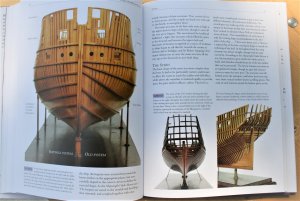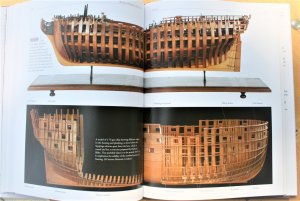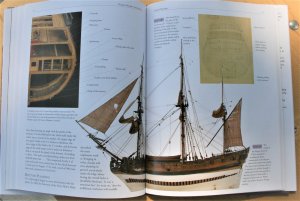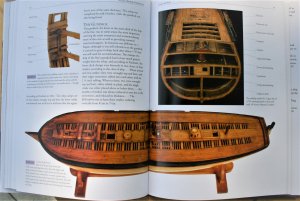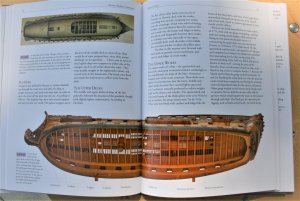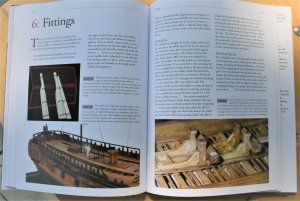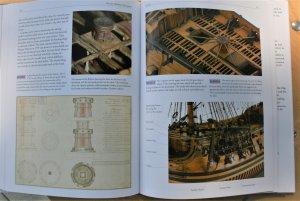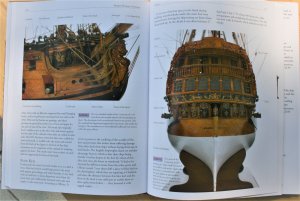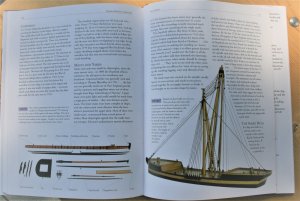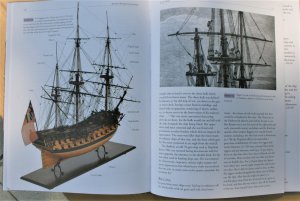Wooden Warship Construction: A History in Ship Models
by Brian Lavery
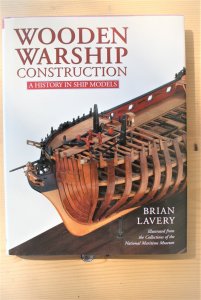
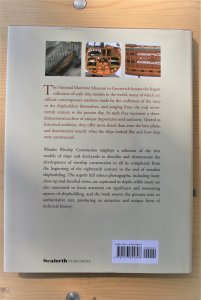
Synopsis:
The National Maritime Museum in Greenwich houses the largest collection of scale ship models in the world, many of which are official, contemporary artifacts made by the craftsmen of the Royal Navy or by the shipbuilders themselves. They range from the mid-seventeenth-century to the present day and represent a three-dimensional archive of unique importance and authority. Treated as historical evidence, these models offer more detail than even the most detailed plans, and demonstrate exactly what the ships looked like in a way that the finest marine painter could not.
This book takes a selection of the best models from the beginning of the eighteenth century to the end of wooden shipbuilding to describe and demonstrate the development of warship construction in all its complexity. For this purpose, it reproduces a large number of photos, all in full color, and includes many close-up and detail views. These are captioned in depth, but many are also annotated to focus attention on interesting or unusual features. Although pictorial in emphasis, the book weaves the illustrations into an authoritative text, producing an unusual and attractive form of technical history.
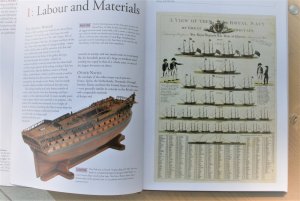
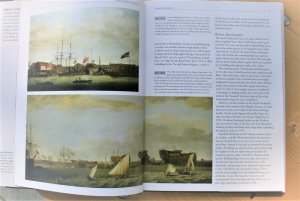
Contents:
1: Labour and Materials (page 6 to 35)
2: Starting the Ship (page 36 to 51)
3: Frames (page 52 to 71)
4: Outside Planking (page 72 to 81)
5: Inside the Hull (page 82 to 97)
6: Fittings (page 98 to 111)
7: In the Water (page 112 to 121)
Appendix, Further Reading
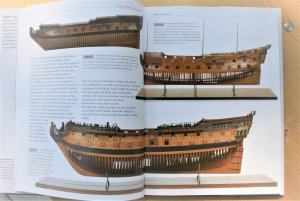
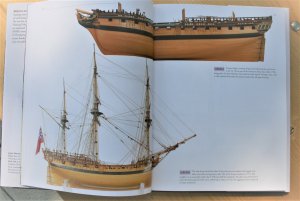
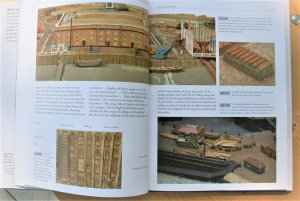
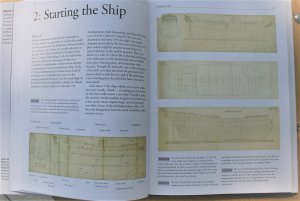
Review:
The book is one of the series “A History in Shipmodels” from Seaforth that uses the model collection of the National Maritime Museum in UK to describe the evolution of naval vessels during the age of sail. The collection of scale ship models is the largest in the world, with most of the models dating from the eighteenth century, but most of the models are not in the public exhibition. Lavery is using the knowledge of and access to the models for a perfect combination of the text and explanations with the pictures.
The book begins with a description of shipyards in the eighteenth century. The layout and specific sites at the facility are explained by using models of a private yard at Buckler’s Hard at Hampshire, England and the Royal Dockyards at Chatham and Deptford. These models are referenced very often to illustrate what is being discussed in the different chapters.
Other books of the Seaforth series have described the layout of frigates and ships of the line and examined their sailing and fighting capabilities on the stage of naval battles and actions, this book goes to the basis and enters the world of shipwrights and dockyards. Lavery is using models of vessels, of dockyards and shipyards, and of construction techniques together with manuscripts and printed sources to create a virtual reality, in which the reader follows the construction of a vessel from the laying down of the keel to the vessel’s launch and to the setting of the masts.
Additional information on any model shown can be obtained by going to the museum’s collections website and entering the corresponding reference number mentioned at the photos.
Several pages of models serve to illustrate the different types of ships built. Than the actual building of a vessel can begin. Ships are made “from the bottom up,” so the keel is the first part assembled and carefully positioned in the slip. Some of the highlights that follow include illustrations of the sternpost and bow structure, a model showing the interior of a seven-frame section with three gun ports, another “of a 74-gun ship showing different stages in the framing and planking”, and other very interesting models are shown, like a midship section etc . Lavery is showing us many details of construction.
A variety of diagrams and models show the complex structure inside the hull made to support the weight of the decks and guns. Other photographs show different phases of decks and planking being built. Some of the fittings like anchors, capstans galley stove are also shown.
Lavery made a high quality book which is recommended to all ship historians and modelers with any interest to understand and to know how these ships were constructed.
Highly recommended especially for the friends of Plank on Frames modelers.
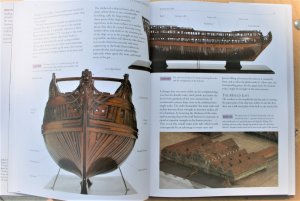
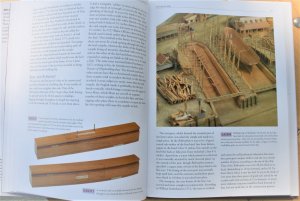

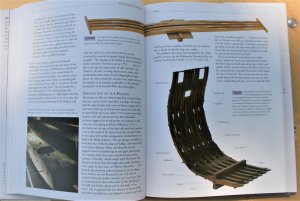
In the next post you can find more photos with Look Inside
by Brian Lavery


- Hardcover: 128 pages
- Publisher: Naval Institute Press; annotated edition edition (April 15, 2017)
- Language: English
- ISBN-10: 1473894808
- ISBN-13: 978-1473894808
- Product Dimensions: 7.2 x 0.6 x 9.9 inches
- Shipping Weight: 1.9 pounds
Synopsis:
The National Maritime Museum in Greenwich houses the largest collection of scale ship models in the world, many of which are official, contemporary artifacts made by the craftsmen of the Royal Navy or by the shipbuilders themselves. They range from the mid-seventeenth-century to the present day and represent a three-dimensional archive of unique importance and authority. Treated as historical evidence, these models offer more detail than even the most detailed plans, and demonstrate exactly what the ships looked like in a way that the finest marine painter could not.
This book takes a selection of the best models from the beginning of the eighteenth century to the end of wooden shipbuilding to describe and demonstrate the development of warship construction in all its complexity. For this purpose, it reproduces a large number of photos, all in full color, and includes many close-up and detail views. These are captioned in depth, but many are also annotated to focus attention on interesting or unusual features. Although pictorial in emphasis, the book weaves the illustrations into an authoritative text, producing an unusual and attractive form of technical history.


Contents:
1: Labour and Materials (page 6 to 35)
2: Starting the Ship (page 36 to 51)
3: Frames (page 52 to 71)
4: Outside Planking (page 72 to 81)
5: Inside the Hull (page 82 to 97)
6: Fittings (page 98 to 111)
7: In the Water (page 112 to 121)
Appendix, Further Reading




Review:
The book is one of the series “A History in Shipmodels” from Seaforth that uses the model collection of the National Maritime Museum in UK to describe the evolution of naval vessels during the age of sail. The collection of scale ship models is the largest in the world, with most of the models dating from the eighteenth century, but most of the models are not in the public exhibition. Lavery is using the knowledge of and access to the models for a perfect combination of the text and explanations with the pictures.
The book begins with a description of shipyards in the eighteenth century. The layout and specific sites at the facility are explained by using models of a private yard at Buckler’s Hard at Hampshire, England and the Royal Dockyards at Chatham and Deptford. These models are referenced very often to illustrate what is being discussed in the different chapters.
Other books of the Seaforth series have described the layout of frigates and ships of the line and examined their sailing and fighting capabilities on the stage of naval battles and actions, this book goes to the basis and enters the world of shipwrights and dockyards. Lavery is using models of vessels, of dockyards and shipyards, and of construction techniques together with manuscripts and printed sources to create a virtual reality, in which the reader follows the construction of a vessel from the laying down of the keel to the vessel’s launch and to the setting of the masts.
Additional information on any model shown can be obtained by going to the museum’s collections website and entering the corresponding reference number mentioned at the photos.
Several pages of models serve to illustrate the different types of ships built. Than the actual building of a vessel can begin. Ships are made “from the bottom up,” so the keel is the first part assembled and carefully positioned in the slip. Some of the highlights that follow include illustrations of the sternpost and bow structure, a model showing the interior of a seven-frame section with three gun ports, another “of a 74-gun ship showing different stages in the framing and planking”, and other very interesting models are shown, like a midship section etc . Lavery is showing us many details of construction.
A variety of diagrams and models show the complex structure inside the hull made to support the weight of the decks and guns. Other photographs show different phases of decks and planking being built. Some of the fittings like anchors, capstans galley stove are also shown.
Lavery made a high quality book which is recommended to all ship historians and modelers with any interest to understand and to know how these ships were constructed.
Highly recommended especially for the friends of Plank on Frames modelers.




In the next post you can find more photos with Look Inside




